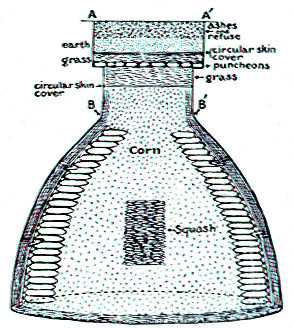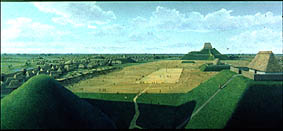 Diagram of food storage pit.
Diagram of food storage pit.
When not needed for food, a stored surplus took on other value. It could be traded for goods or other foods needed or desired. A food surplus could serve as a customary gift or tribute to religious and social elites. Finally, the elites' stored surplus could "finance" public works such as mound construction, clearing of fields, or raising of fortifications. Undoubtedly, prestigious people also used their surplus for gifts as well as community and ceremonial events to enhance their status.
The benefits of having a bountiful and readily storable food source are great. So much so that they may have even surprised and astonished these early American Bottom farmers! It could be eaten in mid-summer when other plant foods had yet to ripen in large quantities. Maize could be grown and stored in sufficient quantities so that it provided a food source through the winter with enough leftover for spring planting. Maize may have given the household greater economic flexibility. That is, it could be left on the stalk in the fall when household hands were needed to harvest other foods (Milner, pers. com. 1998). Maize provided their families with a reliable insurance against inadequate indigenous plant seed production, uncertain hunting success, and poor nut harvests. A stored surplus was insurance against hunger.
 Reconstruction of central plaza at Cahokia, evidence of public works
financed by redistribution & economic surplus.
Reconstruction of central plaza at Cahokia, evidence of public works
financed by redistribution & economic surplus.